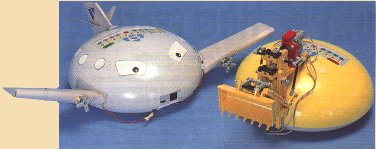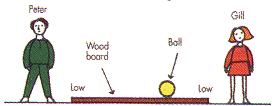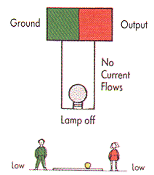
|
Feedback Form

INTRODUCING ROAMER AS A CONTROL DEVICE

At first sight the Roamer is a friendly little robot that runs around the floor in more outfits than Imelda Marcos. There is, however, another side to this giant "Smartie with brains". With the addition of the Roamer Control Box it changes from an intelligent pet to a sophisticated control device capable of introducing control work to the primary class or setting challenges to secondary children. In a series of articles Marcus Topham Senior IT Development Officer with Bradford LEA takes a look at these Roamer features.
 The Roamer aeroplane is typical of the animated models made by young children. It uses two DC motors to turn the propellers. The Lego excavator is a challenge to the abilities of older children. |
The Control Box is the size of a cigarette packet and fits into a recess on the bottom of the Roamer. It has four outputs, a stepper motor drive and an input. The outputs control things like DC motors, lamps and LEDs. The input may be connected to a variety of sensors. Some sensors (e.g. the Sound Sensor) require power to operate them. This is supplied by the Control Box's Sensor Power. There are also ground lines associated with each Output and the Input. Connections to the Inputs and Outputs are through simple screw terminal blocks. This avoids the need for expensive plugs, sockets or cables.
Creating robot characters is one of Roamer's most important educational features. The control capability, enables these robots to be animated and adds an exciting dimension to the product. Robot dogs with wagging tails, bumble bees with flapping wings and robotic disc jockeys complete with their own music and light show are just some of the possibilities. The only limitation is the child's imagination.
The Valiant Accessory Packs are designed to make the development of Roamer models a simple task. You can also use your own equipment, popular construction kits like Lego or the contents of the junk box.
Roamer's Control programming language has a Logo-like structure. It uses Repeat and Procedure commands and is closely related to Valiant's Control Console language.
Roamer Inputs and Outputs can have two states: High or Low. So to turn on a motor (connected to Output 1) you "Set Output 1 High".
High and Low refers to a voltage. Engineers use these terms because it avoids confusion caused by using words like ON and OFF. For example, is a sensor ON when it is activated or when it is stimulated?
|
|
|
Roamer Control Box Technical Details | |
Specification
| Protection
|
Please see the relevant product pages for ordering information and the latest price.
| NEXT ISSUE: Using Roamer's Output facility. |
| Back |
|---|





